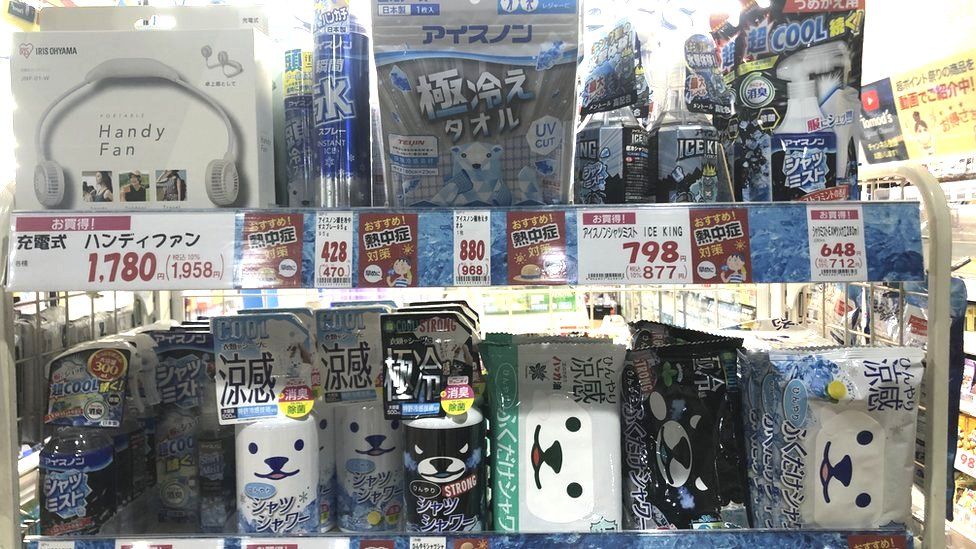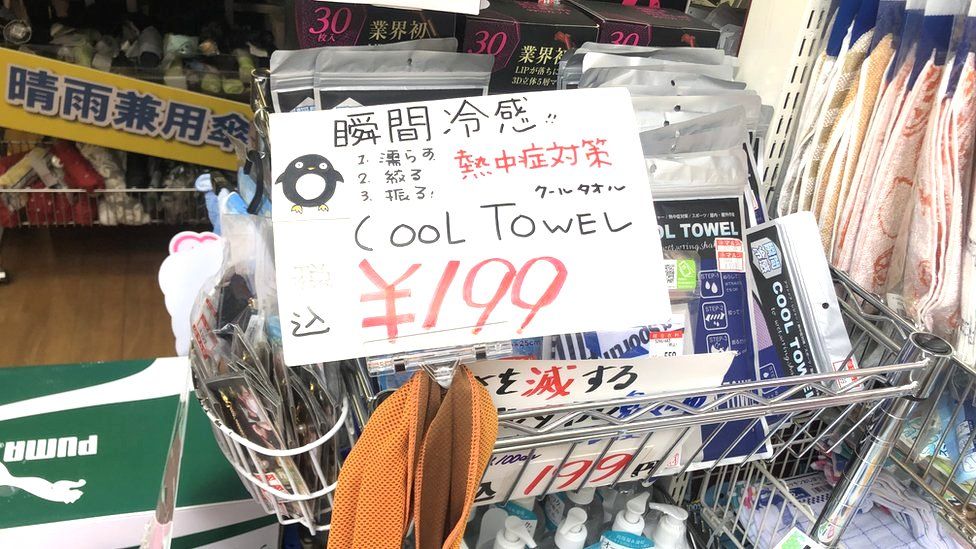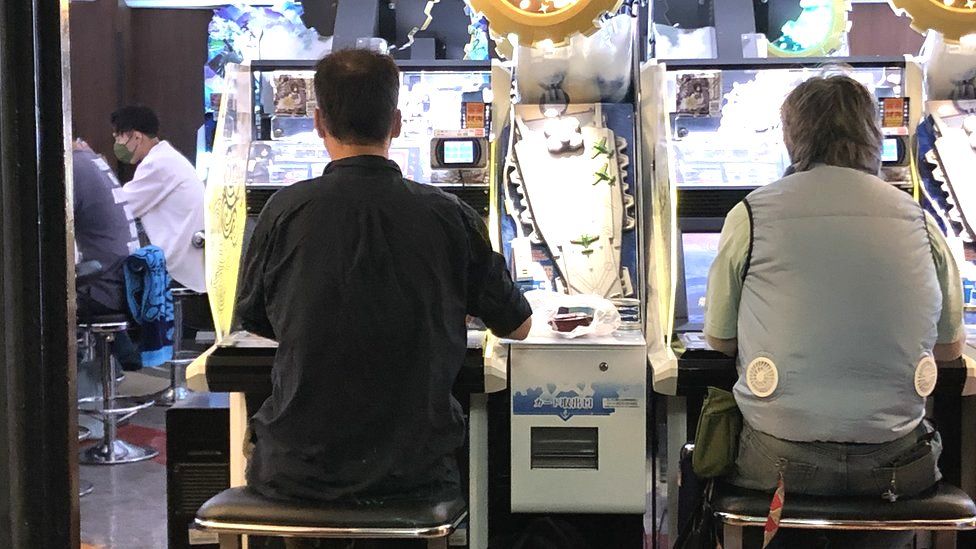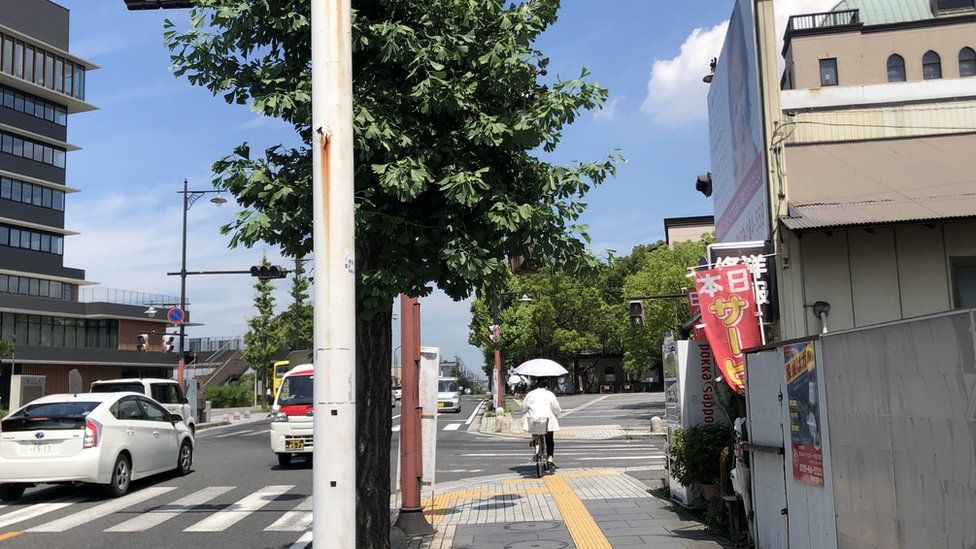How to stay cool the Japanese way
 Christine Ro
Christine RoFace masks remain ubiquitous in Japan, even outdoors on muggy 35C days, so I’m testing out some that promise to provide relief from the heat.
It takes some time to get used to a menthol and eucalyptus-based mask, and not only due to its cough drop smell.
The sensation gets stronger the longer I wear it, to the point that it almost feels like my cheeks are burning. But my face does feel cooler.
So do my arms, after using cooling wipes that leave a surprisingly strong tingle on the skin.
These are just some of the dizzying array of personal products being sold in Japanese cities, where summers are very hot and humid.
The concentration of tall buildings limits shade and intensifies the urban heat island effect, which is where buildings and roads absorb and retain heat and become significantly hotter than surrounding areas with shade or green space.
According to climate researcher Kazutaka Oka, the temperature in Tokyo has increased by 3C in the past century. Of that temperature rise, 1C is attributable to climate change, and 2C is due to the urban heat island.
Using air conditioners is critical to saving lives as temperatures soar. Yet “air conditioning is one of the triggers of the urban heat island”, says Dr Oka. This creates a pressing need for more energy-efficient air conditioning and more renewable energy sources.
Dr Oka is in charge of work on health impact and adaptation at the Center for Climate Change Adaptation, part of the National Institute for Environmental Studies in Tsukuba.

While we speak at his institute, a technician is repairing the lift. He is wearing a jacket containing two fans.
This is an increasingly common sight in Japan. Hand-held electric fans have increased in popularity since 2019, the year after a punishing heatwave. And this year Japan was hit with a heatwave unprecedentedly early.
The early end to the rainy season was coupled with low energy reserves, leading the government to plead with people to reduce their electricity use.
Personal cooling devices could help with that. In general, cooling people rather than cooling rooms with air conditioning can reduce electricity at least tenfold.
There has been an explosion of personal cooling products since the June 2022 heatwave, including UV-blocking parasols and cooling gel sheets for the face.
The Japanese market has so many niches that there are cooling products targeting babies, cyclists and outdoor workers. There are now even wearable fans for dogs.
Dr Oka believes that cooling jackets could be a useful way of adapting to higher temperatures, which of course also need to be curbed. But he emphasises that the technological measures are not silver bullets.
In particular, he says, the products that use mist can provide a cooling effect, but some people complain because they increase humidity.
The 2,580 yen (£16; $19) wearable fan I buy from a convenience store feels heavy around my neck. In 38C weather, during the second of Japan’s summer 2022 heatwaves, it feels as if the fan is just stirring around hot air.

One test of cooling towels, which are meant to be wetted and then worn against the skin, found that skin and body temperatures immediately fell by 1.8C to 2.8C – so they can provide some immediate relief.
They are also extremely popular in Japan’s current hot weather, with retail worker Nana Nihei reporting that sales are up 200% compared with previous years.
Yoshinori Kato is head of product development at the company Showa Shokai which, for the past 21 years, has been manufacturing an ever-expanding range of anti-heatstroke measures,
There have been three distinct phases in sales trends, Mr Kato says. Their first product was salt tablets, in response to reports that dehydrated construction workers were licking soil to get the necessary salt into their bodies.
The second phase was developing portable cooling systems and misters.


The current phase concentrates on products that cool individuals rather than environments. The most popular products now are vests with built-in fans. But past about 35C, these fans become counterproductive due to the entry of hot air.
“In order to counteract that, we need a product that can directly cool the body,” says Mr Kato.
So he shows me a lightweight (590g) black vest to which three cooling units attach. The metal side sucks up heat, while the other side emits heat.
While this can have the effect of heating up the external environment, like air conditioning, Mr Kato says that the product can work in temperatures of up to 40C, including in high humidity.
Many of Showa Shokai’s end users are construction workers and machinists and Mr Kato says a lot of people have told the company they needed something more flexible. Indeed, when I strap on the vest and move around Showa Shokai’s office, I’m surprised at how mobile the garment is.

Refinements to cooling garments like these will face a trade-off between portability and power of the energy source. The mobile battery that powers this vest is the size of a small power bank, and slips into a pocket. It currently lasts only 3.5 hours at full power.
Given the battery life and the price of 30,000 yen, these products are better suited to wearing for short periods of time, and to being bought by employers rather than manual workers themselves.
A self-employed construction worker I speak to uses a vest with fans, paired with an ice pack, while at work. But the battery is expensive, and he has to buy such devices himself, so he saves it for very hot days.

It is important to keep in mind the limitations of such technology.
It would be counterproductive for employers to turn to technology as a way to ensure worker productivity, rather than addressing workloads and rest breaks during extreme heat.
Another issue is that the people most at risk of heatstroke are not the ones using these products the most.
The personal cooling devices are used primarily by younger people and by manual workers, even though it is pensioners who are most at risk as Japan’s temperatures continue to rise.
Wakako Sakamoto is assistant head of environmental safety at Japan’s Environment Ministry. She says in Tokyo in 2021, most people who died of heatstroke were aged 65 and older, and were indoors without air conditioning switched on at the time.

While not everyone has the space or the money for air conditioning, there are still many elderly people with air conditioners installed who do not use them during extreme heat. “We strongly ask these people to use air conditioning,” Ms Sakamoto urges.
Her colleague Takahiro Kasai, who is in charge of measures to tackle heat at the Environment Ministry, adds that some of the most tried and tested personal cooling devices are relatively low-tech.
“A parasol is something that is scientifically proven to shut down sun rays and heat. It also covers the entire body and creates shade for yourself,” she says.
But for people who have these basics covered, personal cooling devices – whether they are parasols, towels or wearable fans – can be a way of staying comfortable and healthy outside the home.


